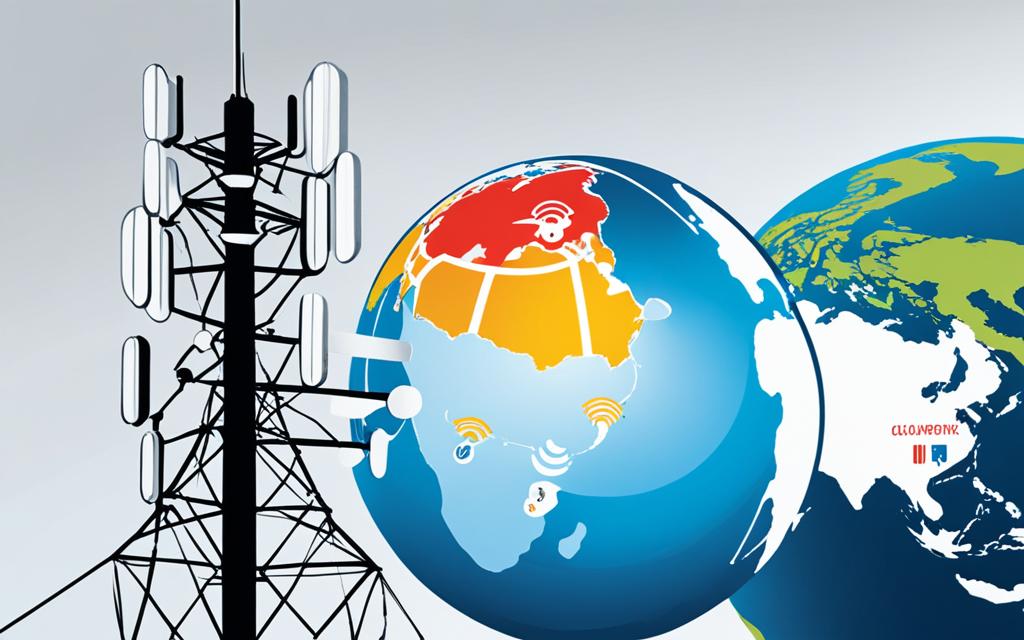Roaming in cellular networks is a game-changer when it comes to global connectivity. Whether you’re a frequent traveler or simply someone who needs to stay connected while on the move, roaming ensures that your mobile device seamlessly communicates with different network providers, no matter where you are in the world.
Roaming has revolutionized communication, allowing you to make calls, send texts, and access data services even when you’re outside your home service area. It’s a feature that keeps you connected, enabling you to stay in touch with loved ones, access critical information, and maintain productivity while on the go.
However, like any technology, roaming comes with its challenges and benefits. On one hand, it provides unparalleled convenience and eliminates the need for multiple SIM cards or relying solely on Wi-Fi. On the other hand, there are potential higher costs and compatibility issues to consider.
In this article, we will delve into the history, evolution, and inner workings of roaming in cellular networks. We will explore the benefits it offers for international travelers and compare it to other connectivity options such as Wi-Fi. By the end, you’ll have a comprehensive understanding of roaming and its significance in our interconnected world.
The History and Evolution of Roaming
In the early days of telecommunications, roaming did not exist, and mobile phones were limited to specific geographic areas. The concept of roaming arose in the late 1990s when mobile operators saw an opportunity to expand their reach and offer services to customers outside their home networks. Roaming agreements were initially made between neighboring countries, but as technology advanced and consumer demand grew, these agreements expanded to cover various regions worldwide. Roaming evolved as a result of technological advancements and the increasing need for seamless communication for travelers and international mobile users.
The expansion of coverage and the evolution of roaming were driven by the following factors:
- Technological advancements: The development of advanced cellular networks and wireless technologies enabled mobile operators to extend their coverage and provide services in areas where they didn’t have a physical presence.
- Roaming agreements: To facilitate seamless communication for their customers, mobile operators started forming roaming agreements with other operators, allowing their subscribers to access services while traveling outside their home network’s coverage area.
- Consumer demand: As people became increasingly mobile and global travel became more prevalent, the demand for staying connected while abroad grew. Consumers wanted to use their devices and have access to voice, text, and data services wherever they went.
As a result of these factors, roaming evolved from a limited concept to a global service that enables mobile users to stay connected and access essential services regardless of their location. This evolution has contributed to the growth and development of the telecommunications industry and has transformed the way we communicate and connect with others.
The Expansion of Roaming Agreements
“Roaming evolved as a result of technological advancements and the increasing need for seamless communication for travelers and international mobile users.”
The expansion of roaming agreements played a significant role in the evolution of roaming. Initially, these agreements were limited to neighboring countries, allowing subscribers to use their mobile devices while traveling across borders. However, as consumer demand for international connectivity grew, mobile operators started forming agreements with operators in different regions worldwide. This expansion of roaming agreements paved the way for global coverage and seamless communication for mobile users.
| Benefits of Roaming Agreements | Examples |
|---|---|
| Expanded coverage | Roaming agreements enabled mobile operators to provide coverage in areas where they didn’t have a physical presence, ensuring that their subscribers can stay connected wherever they go. |
| Increased service availability | Roaming agreements allowed customers to access voice, text, and data services provided by partner networks, ensuring that they can use their mobile devices seamlessly while traveling. |
| Enhanced customer experience | Roaming agreements improved the customer experience by enabling subscribers to use their own devices and maintain their phone numbers while traveling, eliminating the need for purchasing local SIM cards or relying solely on Wi-Fi. |
The expansion of roaming agreements continues to play a crucial role in meeting consumer demand and providing global connectivity. As technology advances further, we can expect to see even more comprehensive roaming agreements that cover a wider range of regions, ensuring that mobile users can stay connected wherever they may be.
How Roaming Works
Roaming is a process that allows mobile users to stay connected even when they are outside the coverage area of their home network. It enables users to connect to partner networks in different locations, ensuring seamless communication and access to essential services. Here’s a breakdown of how roaming works:
Network Compatibility: When a user travels to an area where their home network does not provide coverage, their device automatically searches for a compatible partner network in that location. The device establishes a connection with the partner network, allowing the user to utilize voice, text, and data services.
Partner Networks: Partner networks are cellular networks that have roaming agreements with the user’s home network. These agreements enable users to access services through partner networks as if they were using their home network. Partner networks extend coverage and facilitate seamless roaming experiences for mobile users worldwide.
“Roaming enables users to access voice, text, and data services through different network providers, ensuring seamless communication wherever they go.”
Roaming Charges: Roaming charges are incurred when users utilize voice, text, or data services while roaming. These charges are logged and billed accordingly. Roaming charges can vary depending on the user’s mobile plan and the destination country. It is essential for mobile users to be aware of the potential costs associated with roaming to avoid unexpected charges.
Inter-Operator Settlements: When a user roams on a partner network, the revenue generated from the roaming charges is shared between the partner network and the user’s home network through inter-operator settlements. Inter-operator settlements ensure a fair distribution of revenue and facilitate cooperation between different network operators.
Overall, the roaming process involves connecting to partner networks, incurring roaming charges, and settling payments through inter-operator settlements. This process enables mobile users to enjoy uninterrupted communication and access to services while traveling or outside their home network’s coverage area.

| Benefits of Roaming | Challenges of Roaming |
|---|---|
|
|
Roaming and International Travel
International travel can be an exciting and enriching experience, but it can also present challenges when it comes to staying connected abroad. That’s where roaming comes in. By activating roaming on your mobile device, you can enjoy a range of benefits that keep you connected and make your travel experience more convenient.
The Benefits of Roaming
With roaming, you can use your mobile device to make calls, send messages, and access the internet in foreign countries. This means you can stay in touch with family, friends, and colleagues back home while you’re on the go. Roaming also allows you to keep your existing phone number, so you don’t have to worry about notifying everyone of a new temporary contact number.
Additionally, roaming eliminates the need for purchasing local SIM cards or relying solely on Wi-Fi hotspots. This is particularly beneficial if you’re constantly on the move or if you need to access critical services while traveling, such as online banking or navigation apps.
Potential Costs and Limitations
While roaming offers convenience, it’s important to be aware of the potential costs involved. Roaming charges can vary depending on your mobile plan and destination country. In some cases, rates may be higher compared to domestic usage.
There may also be specific restrictions based on your mobile plan or the country you’re visiting. For example, certain features or services may not be available while roaming, or there may be limitations on data usage. It’s crucial to review your plan details and familiarize yourself with any restrictions or additional charges to avoid any surprises.
Wi-Fi Limitations
Although roaming provides a reliable way to stay connected while traveling, it’s worth noting that it has its limitations. One such limitation is the availability of Wi-Fi. While Wi-Fi hotspots are common in many public places, they may not always be readily accessible or reliable. This could pose a challenge if you heavily rely on internet access or if you need to be online consistently during your travels.
Roaming vs. Wi-Fi: A Comparison
When it comes to accessing the internet while traveling, two popular options come to mind: roaming and Wi-Fi. While both methods offer connectivity, they each have their own set of benefits and limitations to consider. Let’s dive into the details.
Roaming: Seamless Cellular Network Connectivity
Roaming enables users to stay connected to cellular networks even when they are outside their home network’s coverage area. This means you can make calls, send texts, and access data services wherever you go, ensuring seamless communication while traveling. However, it’s important to note that roaming can come with additional charges, depending on your mobile plan and destination.
Wi-Fi: Convenient Wireless Access, with Some Limitations
Wi-Fi provides wireless internet access through hotspots, typically found in public places like cafes, hotels, and airports. Using Wi-Fi can be cost-effective as it doesn’t utilize cellular data. However, Wi-Fi access is limited to specific areas with available hotspots. In addition, connecting to public Wi-Fi networks may pose security risks, as these networks are often unsecured.
When deciding between roaming and Wi-Fi, consider the following factors:
- Cost: Roaming may incur additional charges, while Wi-Fi can be more cost-effective, especially if you have access to free or low-cost hotspots.
- Convenience: Roaming provides seamless connectivity, allowing you to use your own device and phone number without the need for additional settings. Wi-Fi, on the other hand, may require manual connection and authentication processes.
- Security Risks: Roaming utilizes cellular networks, which are typically more secure. Wi-Fi, especially public networks, can pose security risks if not properly secured.
Ultimately, the choice between roaming and Wi-Fi depends on your specific needs and preferences as a user. Consider the costs, convenience, and security implications to make an informed decision.
By weighing the pros and cons of both options, you can ensure that you stay connected while traveling in the most efficient and secure manner.
Conclusion
Roaming plays a vital role in keeping mobile users connected globally, enabling seamless communication and access to essential services. Whether traveling for business or pleasure, roaming offers the convenience of staying connected, ensuring individuals can easily connect with family, friends, and colleagues while abroad.
Not only is roaming beneficial for consumers, but it also holds immense importance for mobile network operators. Roaming generates significant revenue for operators and expands their customer base, as users can continue to utilize their own devices and familiar settings while accessing services in different countries.
While it is essential for mobile users to be aware of potential costs and limitations when roaming, the practical benefits it provides make it an attractive feature for individuals and businesses alike. Roaming allows users to access critical services, send messages, make calls, and browse the internet, all without the need for purchasing local SIM cards or relying solely on Wi-Fi.
As technology continues to advance, we can expect roaming to evolve further and cater to the needs of modern consumers. With the convenience of staying connected and the importance it holds for both users and operators, roaming will continue to ensure global connectivity for all, enhancing communication and enabling seamless connectivity wherever mobile users may be.
FAQ
What is roaming?
Roaming is a feature in the telecommunications industry that allows mobile devices to connect to networks outside their home service areas. It enables users to access voice, text, and data services through different network providers, ensuring seamless communication wherever they go.
When did roaming start?
The concept of roaming arose in the late 1990s when mobile operators saw an opportunity to expand their reach and offer services to customers outside their home networks. Roaming agreements were initially made between neighboring countries and later expanded to cover various regions worldwide.
How does roaming work?
Roaming works by allowing mobile users to connect to partner networks outside their home network’s coverage area. When a user travels to an area where their home network does not provide coverage, their device automatically connects to a compatible partner network in that location. This connection enables users to make and receive calls, send texts, and access data services as if they were using their home network.
What are roaming charges?
Roaming charges are incurred when users utilize voice, text, or data services while roaming. These charges are logged and billed accordingly. The partner network then shares the revenue with the user’s home network through inter-operator settlements.
Why is roaming beneficial for international travelers?
Roaming allows international travelers to stay connected while abroad. With roaming activated, travelers can use their mobile devices to make calls, send messages, and access the internet in foreign countries, eliminating the need for purchasing local SIM cards or relying solely on Wi-Fi. It provides the convenience of using familiar devices and phone numbers, accessing critical services, and staying connected with family, friends, and colleagues while traveling.
What is the difference between roaming and Wi-Fi?
Roaming allows users to connect to cellular networks while traveling, providing seamless connectivity but potentially incurring additional charges. Wi-Fi, on the other hand, offers wireless internet access through hotspots, often found in public places like cafes and hotels. Wi-Fi can be cost-effective as it does not utilize cellular data, but it is limited to specific areas and may pose security risks.



















